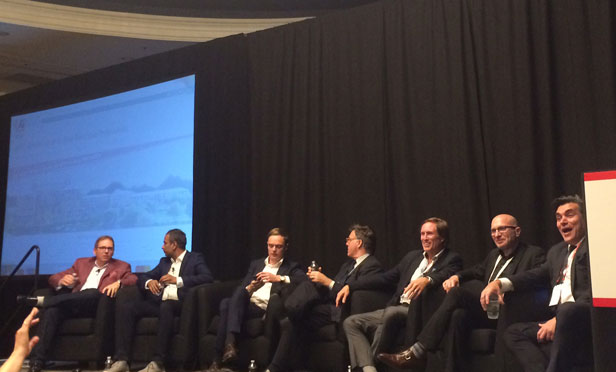 Food Halls panel at ICSC’s RECon 2017 event.
Food Halls panel at ICSC’s RECon 2017 event.
Part 1 of 2
LAS VEGAS—Cushman & Wakefield and the International Council of Shopping Centers hosted a panel discussion on Monday centered on the explosive growth of food-centered retail. The consensus is that while there are all sorts of challenges in the marketplace today, food halls isn’t one of them. That is according to moderator Garrick Brown, VP of retail research for the Americas at Cushman & Wakefield.
Author of the firm’s inaugural Food Halls of America report, and moderator of the panel, Brown said that “no other retail category has generated as much aggressive expansion over the past few years as food-related retail—and arguably, there is no hotter trend within that category than food halls.”
In the first nine months of 2016, Cushman & Wakefield data shows that food hall growth increased by 37.1% year over year with 18 more projects slated for delivery before the end of the year.
The panel, which examined the food hall phenomenon from the user, operator, developer, and financing perspective, discussed what makes a great food hall and how they can thrive in a competitive retail environment.
The panel included celebrity chef and restaurateur Todd English, president of Todd English Enterprises in New York City; Phil Colicchio, president of Colicchio Consulting; Anshul Mangal, managing partner of Now Open Project in Chicago; Nick Giammarco, creative principal of Studio H2G in Birmingham, MI.; Travis Hammond, CEO of Asian food hall concept Eat and Eat; Thomas Rose, head of leisure and restaurants for Cushman & Wakefield in London; and Eldon Scott, president of Urbanspace Food Hall in New York City.
There are 13 billion square feet of retail in the US and we are probably going to see 1 billion square feet of that go away, said Brown, but food is the major growth driver everywhere and it is taking off beyond anyone’s expectations, he said. “Food halls are here to stay and it is going to be the hottest growth story in retail for the next few years.”
According to panelist Giammarco, food halls are redefining the way we eat. “We are witnessing a cultural phenomenon. For the first time in recent history, we have an emergence in food culture that is uniquely American,” he said. And with access and availability of information and social media, tv, food channels and more, our society is so educated on food. Another contributing factor for the phenomenon is due to technology, he added.
But design, “good design,” must respond to consumer’s hyper expectations, Giammarco added. “There must be a mind shift on how we engage. Leasing does not drive the bus, consumers do.”
He explains that replacing food courts with food halls is simply no longer enough and no longer effective. “The need to think differently is driven by consumer demands. Retail districts must have a strong sense of place and authenticity. Think of it as an ecosystem.”
Giammarco encouraged developers to not limit their strategies to the confines of the food hall. “We must give consumers a reason for brick and mortar to exist. It is changing, it isn’t dying. But we must adapt and do things differently.”
So who is doing it right? Perhaps Todd English Enterprises for one. According to English, traveling and working in Asia and Europe following culinary school helped him learn. And since then, there has been a whole evolution of food. “Consumers just wanted something different,” he said.
But he wasn’t always an expert. He said that a food hall really has to be curated right. “We have to be careful that there is some sort of sensibility of what it is.” he emphasized cleaniness, continuity and fresh product as key ingredients for success. “The bar has to be set at a very high level.”
Check back in the next day or so for part two from this dynamic panel where, among other things, we cover more on authenticity and operating considerations.

















 Copyright © 2024 ALM Global, LLC. All Rights Reserved.
Copyright © 2024 ALM Global, LLC. All Rights Reserved.